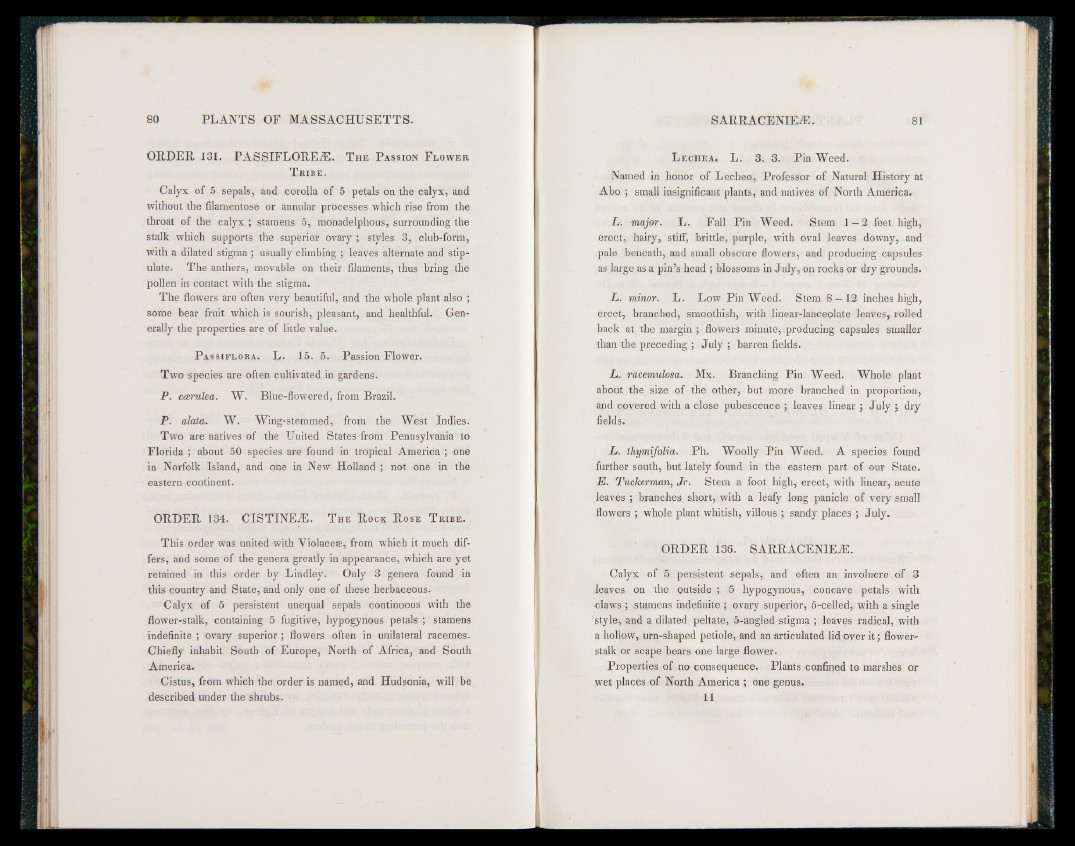
ORDER 131. PA S S IFLO R E jE . T he P assion F lower
T r ib e .
Calyx of 5 sepals, and corolla of 5 petals on the calyx, and
without the filamentose or annular processes which rise from the
throat of the calyx ; stamens 5, monadelphous, surrounding the
stalk which supports the superior ovary ; styles 3, club-form,
with a dilated stigma ; usually climbing ; leaves alternate and stipulate.
The anthers, movable on their filaments, thus bring the
pollen in contact with the stigma.
The flowers are often very beautiful, and the whole plant also ;
some hear fruit which is sourish, pleasant, and healthful. Generally
the properties are of little value.
P assiflora. L. 15. 5. Passion Flower.
Two-species are often cultivated in gardens.
P . ccerulea. W. Blue-flowered, from Brazil.
P . alata. W. Wing-stemmed, from the West Indies.
Two are natives of the United States from Pennsylvania to
Florida ; about 50 species are found in tropical America ; one
in Norfolk Island, and one in New Holland ; not one in the
eastern continent.
ORDER 134. C IST IN EiE. T he R ock R ose T r ib e .
This order was united with Violaceae, from which it much differs,
and some of the genera greatly in appearance, which are yet
retained in this order by Lindley. Only 3 genera found in
this country and State, and only one of these herbaceous.
Calyx of 5 persistent unequal sepals continuous with the
flower-stalk, containing 5 fugitive, hypogynous petals ; stamens
indefinite ; ovary superior ; flowers often in unilateral racemes.
Chiefly inhabit South of Europe, North of Africa, and South
America.
Cistus, from which the order is named, and Hudsonia, will be
described under the shrubs.
L echea. L. 3. 3. Pin Weed.
Named in honor of Lecheo, Professor of Natural History at
Abo ; small insignificant plants, and natives of North America.
L. major. L. Fall Pin Weed. Stem 1 - 2 feet high,
erect, hairy, stiff, brittle, purple, with oval leaves downy, and
pale beneath, and small obscure flowers, and producing capsules
as large as a pin’s head ; blossoms in July, on rocks or dry grounds.
L . minor. L. Low Pin Weed. Stem 8 - 1 2 inches high,
erect, branched, smoothish, with linear-lanceolate leaves, rolled
back at the margin ; flowers minute, producing capsules smaller
than the preceding ; July ; barren fields.
L . racemulosa. Mx. Branching Pin Weed. Whole plant
about the size of the other, but more branched in proportion,
and covered with a close pubescence ; leaves linear ; July ; dry
fields.
L . thymifolia. Ph. Woolly Pin Weed. A species found
further south, hut lately found in the eastern part of our State.
E. Tuckerman, Jr. Stem a foot high, erect, with linear, acute
leaves ; branches short, with a leafy long panicle of very small
flowers ; whole plant whitish, villous ; sandy places ; July.
ORDER 136. S ARRACENIEiE.
Calyx of 5 persistent sepals, and often an involucre of 3
leaves on the outside ; 5 hypogynous, concave petals with
claws ; stamens indefinite ; ovary superior, 5-celled, with a single
style, and a dilated peltate, 5-angled stigma ; leaves radical, with
a hollow, urn-shaped petiole, and an articulated lid over i t ; flower-
stalk or scape bears one large flower.
Properties of no consequence. Plants confined to marshes or
wet places of North America ; one genus.
11